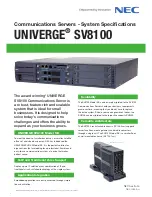
Intel® Server Board S2600CW Family TPS
Intel® Server Board S2600CW Functional Architecture
Revision 2.4
37
Express Root Port on another subsystem. NTB supports three 64bit BARs as configuration
space or prefetchable memory windows that can access both 32bit and 64bit address space
through 64bit BARs.
There are 3 NTB supported configurations:
NTB Port to NTB Port Based Connection (Back-to-Back).
NTB Port to Root Port Based Connection – Symmetric Configuration. The NTB port on
the first system is connected to the root port of the second. The second system’s NTB
port is connected to the root port on the first system making this a fully symmetric
configuration.
NTB Port to Root Port Based Connection – Non-Symmetric Configuration. The root
port on the first system is connected to the NTB port of the second system. It is not
necessary for the first system to be an Intel® Xeon® Processor E5-2600 Product
Families system.
Note:
When NTB is enabled, Spread Spectrum Clocking (SSC) is required to be disabled at each
NTB link.
3.4.4
PCIe SSD Support
The board supports PCIe SSD as cabled add-in card on existing PCIe slots. The x16 PCIe
add-in card can support up to four x4 PCIe SSD 2.5” drives with mini-SAS HD cables
connected to the hot-swap backplane.
The ingredients for PCIe SSD:
PCIe SSD cabled add-in card: cable PCIe link through add-in card in existing PCIe slots,
support four x4 PCIe SSD 2.5” drives.
Combo hot-swap backplane supporting SAS/SATA drives and PCIe SSDs.
Four x4 mini-SAS HD cables connecting add-in card and combo HSBP.
8 x 2.5” Drives: 4 SAS/SATA + 4 PCIe SSD 2.5”
Hot-plug and enclosure management features are not supported with PCIe SSD devices.
The PCIe SSD add-in-card needs to be used on electrically x16 PCIe slot. On S2600CW2R and
S2600CWTR, the add-in-card can be used on PCIe slot 2/4/5/6. On S2600CW2SR and
S2600CWTSR, the add-in-card can be used on PCIe slot 2/4/6 (PCIe slot 5 is electrically x8
bandwidth).
Note
:
















































